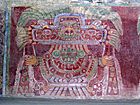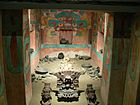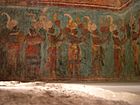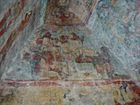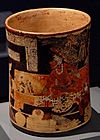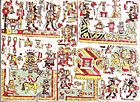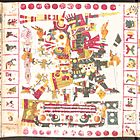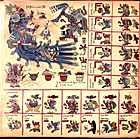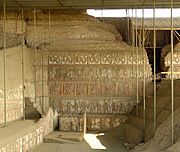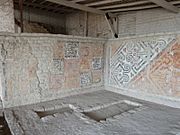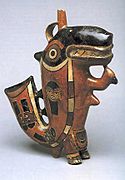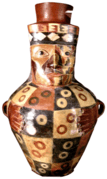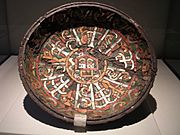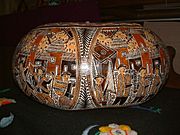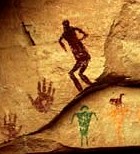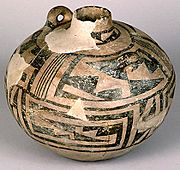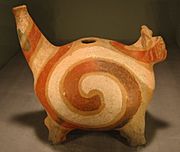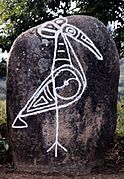Painting in the Americas before European colonization facts for kids
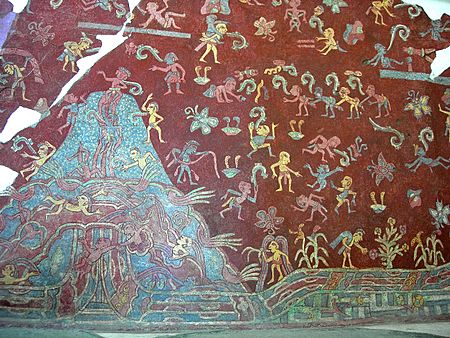
Before Europeans arrived, people in the Americas created amazing paintings. These artworks were a popular way to share ideas and express beliefs. They were used for both religious ceremonies and everyday life. People painted on many surfaces, like cloth, animal hides, rocks, and even their own bodies. They also decorated pottery, walls inside buildings, and wooden panels.
Many paintings on materials like cloth have not lasted over time. However, paintings on pottery, walls, and rocks have survived much better. The oldest known paintings in South America are cave paintings in the Brazilian Amazon rainforest. They are about 11,200 years old! In North America, the oldest known painting is on a bison skull found in Oklahoma. It dates back to 10,200 BCE.
Contents
Ancient American Paintings
The Americas were home to many unique cultures. Each one developed its own special art, including paintings. These paintings often showed religious symbols or were used for decoration. Art from indigenous people in the Americas had a huge impact on European art, and vice versa. This exchange happened during and after the Age of Exploration.
Mesoamerica
Mesoamerica is a historical region that includes parts of modern-day Mexico and Central America. Ancient civilizations like the Maya and Teotihuacan created incredible murals here.
Teotihuacan Murals
The city of Teotihuacan was famous for its murals. These paintings covered many buildings and are a main source of information about this ancient civilization. The best time for painting in Teotihuacan was between 450 and 650 CE. The artists there were incredibly skilled.
The Great Goddess
One important discovery at Teotihuacan was a series of murals in the Tepantitla area. At first, people thought the main figure was Tlaloc, the god of rain. But later, a researcher named Esther Pasztory studied the murals again. She realized that many of these figures were actually a feminine deity. This goddess was linked to plants and fertility. She is now known as the Great Goddess of Teotihuacan. Her image has been found in several other places in Teotihuacan as well.
The Temple of the Murals
Large Mayan murals were found at an archaeological site called Bonampak in Mexico. This site has a long, narrow building with three rooms on top of a low pyramid. The walls inside these rooms have some of the best examples of classic Maya painting. Huge paintings cover the walls of one room. They tell the story of a battle and how one side won.
-
Great Goddess of Teotihuacan mural from Tetitla, Mexico.
-
Mural from Tepantitla in Teotihuacan, a copy in the National Museum of Anthropology.
-
Painting on the Lord of the jaguar pelt throne vase, a scene of the Maya court, 700–800 AD.
-
Painted pottery figurine of a King from Jaina Island, Mayan art, 400–800 AD.
-
Painted relief from the Maya site Palenque, showing the son of K'inich Ahkal Mo' Naab' III.
-
A Mixtec painting from the Codex Zouche-Nuttall.
-
An Aztec painting from the Codex Borgia, showing Mictlantecuhtli and Quetzalcoatl.
-
An Aztec painting from the Codex Borbonicus, showing Tlaloc.
-
A painting from Codex Mendoza showing the Aztec legend of the founding of Tenochtitlán, c.1553.
South America
Nazca Culture
The Nazca culture in Peru was known for its painted pottery. They created ceramics with religious and symbolic figures, as well as images of people. They also made complex textiles and huge Geoglyphs (designs on the ground). The Nazca culture was most active from 1 to 700 AD. We learn about their culture by studying Cahuachi, their main ceremonial center.
-
Moche murals from the Huaca de la Luna site, Peru, 100–700 AD.
-
Killer Whale, slip glazed pottery, Nazca culture, 300 BC–800 AD, Larco Museum, Lima, Peru.
-
Painted pottery from the Huari culture of Peru, 500–1200 AD.
-
Peruvian Bowl from the Pre-Columbian era, Museum of the Nation, Lima, Peru.
North America
Many different Native American tribes in what is now the United States created paintings. They also made many painted objects. The oldest known example is the Cooper Bison skull. It was painted with a red zigzag around 10,200 BCE in present-day Oklahoma.
United States
Ancient North America saw a lot of body painting, rock art, and hide painting. People also painted on pottery, textiles, and other surfaces. The Ancestral Puebloans of the American Southwest had a long tradition of painting murals inside buildings and decorating pottery. The Mogollon culture, ancestors of the Zuni and Hopi tribes, also painted ceramics. The Fremont culture in Utah is famous for its many rock paintings. The Hohokam people, ancestors of the Akimel O'odham and Tohono O'odham, were known for their red-on-buff painted pottery.
Native Americans in California created many pieces of rock art. The most detailed painted pictographs were made by the Rock art of the Chumash people. The Coso people created impressive petroglyphs. Along the Northwest Coast, ancient art featured "formline" painting on woven items and wood. However, few of these items have survived due to the wet climate.
-
Pictograph, southeastern Utah, ca. 1200 BCE.
-
The Great Gallery, Pictographs, Canyonlands National Park, Horseshoe Canyon, Utah, ca. 1500 BCE.
-
Ancestral Pueblo ceramic canteen from Chaco Canyon, New Mexico, c. 700–1100 CE.
-
Painted ceramic jug showing the underwater panther from the Mississippian culture, found at Rose Mound, Arkansas, c. 1400-1600 CE.
Canada
-
A totem pole in Totem Park, Victoria, British Columbia.
-
From Totem Park, Victoria, British Columbia.
Caribbean
-
Taíno petroglyph at Caguana Indigenous Ceremonial Center, Utuado, Puerto Rico.


